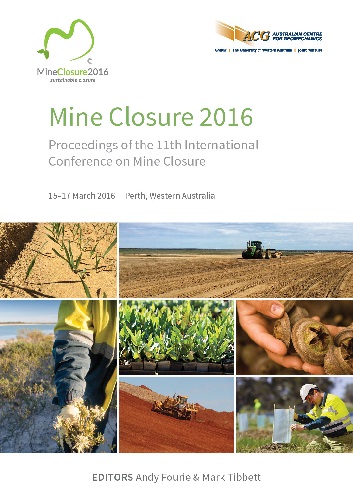When is it time to say enough is enough for historical mine rehabilitation and closure? A Pilbara case study

|
Authors: Finucane, SJ; Bastow, B |
DOI https://doi.org/10.36487/ACG_rep/1608_26_Finucane
Cite As:
Finucane, SJ & Bastow, B 2016, 'When is it time to say enough is enough for historical mine rehabilitation and closure? A Pilbara case study', in AB Fourie & M Tibbett (eds), Mine Closure 2016: Proceedings of the 11th International Conference on Mine Closure, Australian Centre for Geomechanics, Perth, pp. 369-380, https://doi.org/10.36487/ACG_rep/1608_26_Finucane
Abstract:
Mine rehabilitation and closure standards, and stakeholder expectations regarding these, have changed significantly over time. In particular, over the last 20 years, regulator, community and industry expectations on what constitutes acceptable rehabilitation and walk-away solutions have increased dramatically. This has improved rehabilitation and closure outcomes, but this has also raised the bar to an often unrealistic level for historical mine sites. It can increase closure costs, prolong (or even prevent) site relinquishment and damage stakeholder confidence in a company’s and the broader industry’s ability to undertake mining in a sustainable manner. Is it fair to expect a historical site to meet modern standards or are these expectations setting up operations and companies to fail? The imposition of current or future closure standards on older operations is a major concern for industry. There is a need for a new approach and dialogue regarding the actual environmental and community risks associated with historical sites, and what rehabilitation and closure standards are practical and should apply. If there are no sensitive receptors and the risks have been contained or are being managed effectively, why go any further? This does not mean that mine operators should ignore their responsibilities and that new mines should not be expected to achieve higher standards or best practice, but decisions need to be made on the most practical, pragmatic and cost-effective way to utilise what are often limited resources in rehabilitating and closing historical mines. To adopt a new approach, it is important that stakeholders understand the standards that were applied when mining at a site commenced and/or when a mine was operational, and what closure outcomes are realistic. Perhaps there are alternative, and possibly better, environmental outcomes that can be achieved rather than trying to achieve the impossible on a site that was not set up to current-day standards? This paper discusses the Blue Spec Shear Gold-Antimony Project near Nullagine, Western Australia, and draws on other examples, to trigger a conversation within industry, regulators and the community about whether historical sites can meet modern rehabilitation and closure standards, and if a new site relinquishment approach is required.
Keywords: reliquishment, alternative closure approach, stakeholders, legacy sites
References:
Bioscope Environmental Consulting Pty Ltd 2013, Blue Spec Gold-Antimony Project Mine Closure Plan, Working draft report prepared for Northwest Resources Limited, Perth.
Botham, N, Bower, G, Vercoe, J & Lerotholi, N 2013, ‘Mine closure liabilities and risk management – minimising the pitfalls in decommissioning policy, in Environment and Society Conference, The Southern African Institute of Mining and Metallurgy Mining.
Danielson, L & Nixon, M 1999, ‘Current regulatory approaches to mine closure in the United States’, in A Warhurt & L Noronha (eds), Environmental Policy in Mining. Corporate Strategy and Planning or Closure, Lewis Publishers, Boca Raton, pp. 311–350.
DER (Department of Environment Regulation) 2014, Assessment and Management of Contaminated Sites. Contaminated Sites Guidelines, Government of Western Australia, Perth.
Didier, C, Van Der Merwe, N, Betournay, M, Mainz, M, Kotyrba, A, Aydan, O, Josien, JP & Song, WK 2008, Mine Closure and Postmining Management International State-of-the-Art, International Commission on Mine Closure, International Society for Rock Mechanics.
Didier, C, Van Der Merwe, N, Betournay, M, Mainz, M, Aydan, O, Kotyrba, A, Song, WK & Josien, J 2009, ‘Presentation of the ISRM mine closure state of the art report’,in SINOROCK 2009: ISRM-sponsored International Symposium on Rock Characterisation, Modelling and Engineering Design Methods.
DMP & EPA (Department of Mines and Petroleum & Environmental Protection Authority) 2015, Guidelines for Preparing Mine Closure Plans, Government of Western Australia, Perth.
Environment and Security Initiative 2005, Mining for Closure: Policies and Guidelines for Sustainable Mining Practice and Closure of Mines, United Nations Environment Programme, viewed 21 August 2015,
ICMM (International Council on Mining & Metals) 2005, Biodiversity Offsets – A Briefing Paper for the Mining Industry, International Council on Mining & Metals, London.
ICMM (International Council on Mining & Metals) 2006, Integrated Closure Planning, International Council on Mining & Metals, London.
Miller, G 2005, Financial Assurance for Mine Closure and Reclamation, International Council on Mining & Metals, London.
O’Brien Planning Consultants 1999, Municipal Heritage Inventory for the Shire of East Pilbara, Subiaco, Western Australia.
Robertson, AM & Shaw, SC 1999, ‘The concept of custodial transfer of mined land’, in IMWA Proceedings 1999, International Mine Waste Association, pp 765–771.
SRK Consulting 2012, Blue Spec Shear Gold-Antimony Project Contaminated Sites Strategic Analysis, Confidential final draft report prepared for Northwest Resources Limited, Perth.
Unger, C 2014, What should we do with Australia’s 50,000 abandoned mines?, viewed 26 September 2015,
URS 2012, Blue Spec Shear Gold-Antimony Project Preliminary Site Investigation, Confidential final report prepared for Northwest Resources Limited, Perth.
Ward, C 2015, ‘Miners’ liability to redress reduced water quantity and quality after mine site closure: A case study of the Collie Coalfields in Western Australia’, Environmental and Planning Law Journal (2015) 32 EPLJ 455, viewed 15 October 2015,
© Copyright 2025, Australian Centre for Geomechanics (ACG), The University of Western Australia. All rights reserved.
View copyright/legal information
Please direct any queries or error reports to repository-acg@uwa.edu.au
View copyright/legal information
Please direct any queries or error reports to repository-acg@uwa.edu.au